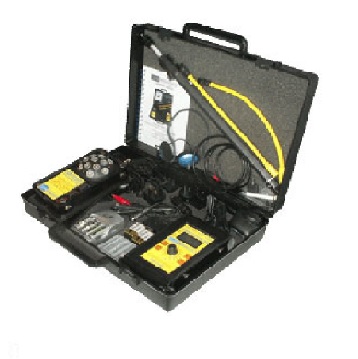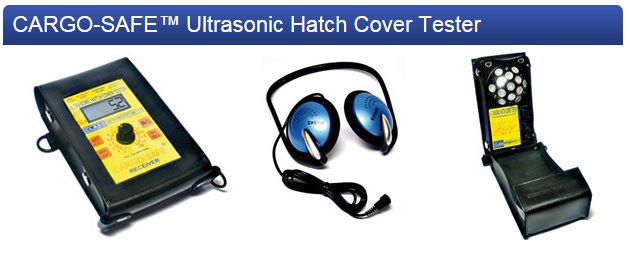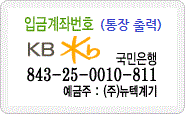26
Ultrasonic Hatch Cover Tester (CARGO-SAFE¢â)

CARGO-SAFE¢â Features
Unlike hose testing, ultrasonic hatch cover testing:
* is compliant with port and harbour environment management plans as it does not pollute the marine environment
* can locate holes and tears in hatch seals with pinpoint accuracy
* causes no damage to cargo
* can be conducted in sub-zero temperatures
* can be carried out with the cargo in place
* does not interfere with other crew activities.


Overview of UT testing
CARGO-SAFE¢â The choice of marine surveyors across the globe
The ingress of water through leaking hatch covers is a main cause of damage to cargo. It is in the interest of ship owners,
managers and insurers to guarantee the cargo hold is watertight, as damaged cargo caused by water leaking through hatch
covers often results in large claims against insurance companies and P&I clubs.
|
|
CARGO-SAFE¢â is an ABS Type Approved hatch cover tester. The CARGO-SAFE¢â UT tester provides a quick and simple method of establishing weather tightness of hatch covers, bow, stern and side doors, but unlike hose testing, has no negative side effects on the port or harbour environment and can be performed in sub-zero temperatures. 3 year Warranty and 5 year re-calibration interval *see Warranties under Support |
 Á¦Ç°µ¿¿µ»ó
Á¦Ç°µ¿¿µ»ó
 Á¦Ç°±¸¼º
Á¦Ç°±¸¼º
|
|
|
|
|
CARGO-SAFE¢â Ultrasonic Hatch Cover Tester Applications To test the tightness and water integrity of
CARGO-SAFE Printer friendly information sheetA guide to conducting a hatch cover survey using a CARGO-SAFE |
CARGO-SAFE¢â Features
Unlike hose testing, ultrasonic hatch cover testing:
- is compliant with port and harbour environment management plans as it does not pollute the marine environment
- can locate holes and tears in hatch seals with pinpoint accuracy
- causes no damage to cargo
- can be conducted in sub-zero temperatures
- can be carried out with the cargo in place
- does not interfere with other crew activities.
Other CARGO-SAFE features
• Each CARGO-SAFE¢â ultrasonic hatch leak detector comes with its own certificate of calibration and conformity.
• No training needed to operate - full instructions given.
• Simple to use, fast and accurate results.
• Switchable between dB (decibels) and percentage of OHV (Open Hatch Value).
• Does not need frequent periodic recalibration.
• Suitable to be carried as hand luggage on aircraft.
• The most powerful ultrasonic hatch tester available on the market with a 157 dB transmitter ¡© suitable for any size of ship.
• 3 year warranty on Receiver and Transmitter.
• Durable and storm proof, environmental protection to IP66.
• LCD display allows ease of reading in bright sunshine or in darkness.
• LED and sound warning of low battery on the Transmitter.
• Direct access to free technical support for the life of the product.
CARGO-SAFE¢â Calibration and Maintenance
The CARGO-SAFE¢â ultrasonic hatch leak detection system is sold with a device that can be used to check the emitters,
the inspection microphones, the extension arm and microphone emergency lead (The EMEA Tester).
It is recommended that this is done before each survey, to ensure accurate results.
The CARGO-SAFE¢â hatch leak detector is calibrated at the factory and is predicted to stay in calibration for 5 years.
The constant output circuitry guarantees the ultrasonic output of the Transmitter is constant over the entire discharge
cycle of the batteries, validated by the green flashing LEDs.
CARGO-SAFE¢â Certificates and ABS Type Approval Compliance
Each CARGO-SAFE¢â unit is sold with a certificate of calibration and conformity, giving full details of serial numbers and
warranty periods. This certificate is evidence of each unit¡¯s calibration and ABS Type Approval compliance.
The CARGO-SAFE¢â hatch cover tester complies with the IACS UR Z.17 Directive.
The certificate of origin confirms that CARGO-SAFE¢â is manufactured in the United Kingdom.
CARGO-SAFE¢â After Sales Technical Support
Class Instrumentation Limited guarantees the CARGO-SAFE¢â ultrasonic hatch cover tester to be free from defects
in materials and workmanship for a period of three years from the date of dispatch for the Receiver & Transmitter units and
six months for the accessories. Free telephone and email technical support are available throughout the life of the product.
CARGO-SAFE¢â Technical Specification
CARGO-SAFE¢â is a lightweight ultrasonic system for testing the water tightness of cargo hatch covers.
The complete system is contained in one carry case for convenient transportation.
Shipping Weight: 4kg (8.8lb)
Operational Weight: 2.4kg (5.3lb)
|
Transmitter
|
|
|
Receiver
|
|
|
Microphone
|
|
|
Headphones
|
|
|
Emitter, Microphone and Extension Arm Tester
|
|
|
Extension Arm
|
|
|
Spare Microphone and Emergency Lead
|
|
|
Battery Charger and Batteries
|
|
|
Emergency Power Lead
|
|
CARGO-SAFE¢â How it Works
How the CARGO-SAFE¢â Ultrasonic Hatch Cover Tester Works
The principle for ultrasonic hatch cover testing is very simple. After the hatch covers are closed, a transmitter generating an ultrasonic signal
is placed in the cargo hold (empty or loaded with cargo) emitting ultrasonic waves. The surveyor or operator then uses the CARGO-SAFE¢â
ultrasonic receiver to ¡®listen¡¯ from the outside of the hold and detect any ultrasonic sounds that pass through holes in the hatch cover sealing
system with pin-point accuracy. The size of the leak can be established from the strength of the signal detected.
The CARGO-SAFE¢â hatch cover leak detection system has three levels of emitters: upper, lower and vertical. This means that all the ultrasound
is directed to the hatch covers, optimising its effectiveness. The diagram shows the dispersion pattern of the ultrasonic sound emanating from
the CARGO-SAFE¢â Transmitter. The high sound pressure level is ample to fill the largest of holds enabling reliable and accurate readings.

Step by Step Guide to a Survey
1. The CARGO-SAFE¢â Transmitter is placed in the cargo.
2. On the deck, with the hatches closed, the microphone and headphones are plugged into the Receiver.
3. The surveyor begins to inspect the hatch, holding the microphone against the hatch seals. Any gaps through which air or water can pass
will allow the ultrasonic signal to pass and can be detected.
4. The display on the Receiver shows the decibel level of any ultrasound leaking through the hatch seals. It can also be heard through the headphones.
5. The flexible microphone and the extension arm allow the position of any potential leaks to be identified with pin-point accuracy.
The size of the problem is established by the strength of the signal detected.

























